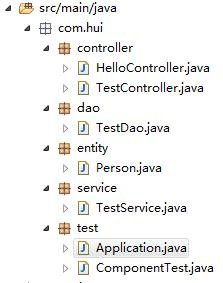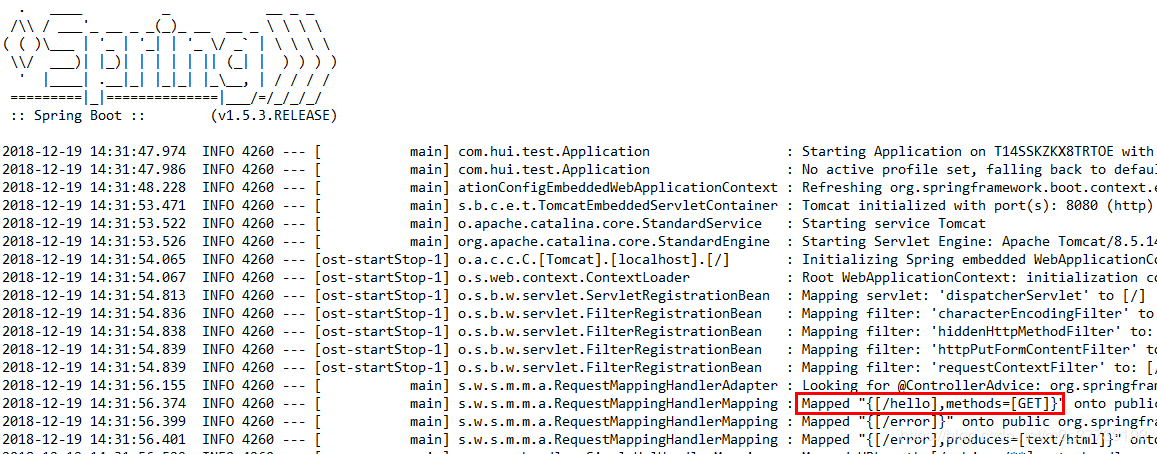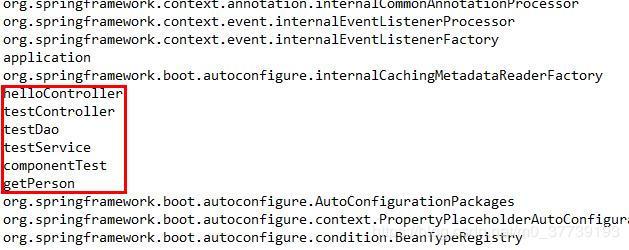Springboot注解@ServletComponentScan和@ComponentScan(转)
一、SpringBoot中使用Servlet
在SpringBootApplication上使用@ServletComponentScan注解后,Servlet、Filter、Listener可以直接通过@WebServlet、@WebFilter、@WebListener注解自动注册,无需其他代码。
1.在入口Application类上加入注解@ServletComponentScan
package com.hui; import org.springframework.boot.SpringApplication;
import org.springframework.boot.autoconfigure.SpringBootApplication;
import org.springframework.boot.web.servlet.ServletComponentScan; @SpringBootApplication
@ServletComponentScan
public class Application { public static void main(String[] args) {
SpringApplication.run(Application.class, args);
}
}
2.新建Servlet类,继承HttpServlet并且加入注解@WebServlet(name=“TestServlet”,urlPatterns="/test")
package com.hui.qiang; import java.io.IOException; import javax.servlet.ServletException;
import javax.servlet.annotation.WebServlet;
import javax.servlet.http.HttpServlet;
import javax.servlet.http.HttpServletRequest;
import javax.servlet.http.HttpServletResponse; @WebServlet(name="TestServlet",urlPatterns="/test")
public class TestServlet extends HttpServlet { private static final long serialVersionUID = 1L; @Override
protected void doGet(HttpServletRequest req, HttpServletResponse resp)
throws ServletException, IOException {
System.out.println("doGet");
}
}
3.之后运行代码,在浏览器地址栏输入http://localhost:8080/test,若看到控制台打印doGet,则表示Servlet创建成功。
注意:
(1)如果不加@ServletComponentScan注解则会报404即找不到页面,控制台也扫描不到我们配置的servlet:/test,即无法被映射
(2)如果Application类和Servlet类不在同一包下,则@ServletComponentScan需要添加相应的路径,如Application类在包com.hui.xiao下,则写为@ServletComponentScan(“com.hui.xiao”)或@ServletComponentScan(“com.hui”)


二、Spring, Spring Boot中的@ComponentScan注解用法介绍
@ComponentScan
如果你理解了ComponentScan,你就理解了Spring.
Spring是一个依赖注入(dependency injection)框架。所有的内容都是关于bean的定义及其依赖关系。
定义Spring Beans的第一步是使用正确的注解-@Component或@Service或@Repository.
但是,Spring不知道你定义了某个bean除非它知道从哪里可以找到这个bean.
ComponentScan做的事情就是告诉Spring从哪里找到bean
由你来定义哪些包需要被扫描。一旦你指定了,Spring将会将在被指定的包及其下级的包(sub packages)中寻找bean
下面分别介绍在Spring Boot项目和非Spring Boot项目(如简单的JSP/Servlet或者Spring MVC应用)中如何定义ComponentScan
注:@ComponentScan的不同写法
1.@ComponentScan({“com.xiao.hui”,“com.xiao.qiang”})或@ComponentScan(basePackages = {“com.xiao.hui”,“com.xiao.qiang”})
2.@ComponentScan(“com.xiao”)或@ComponentScan(value = “com.xiao”)或@ComponentScan(basePackages = { “com.xiao” })
3.@ComponentScan(basePackageClasses=要扫描类.class所在位置的包) 意思是要扫描哪个类所在的包,如@ComponentScan(basePackageClasses=hehe.class),这种写法不如上面的那种写法好有局限性
Spring Boot项目
总结:
1.SpringBoot在写启动类的时候如果不使用@ComponentScan指明对象扫描范围,默认指扫描当前启动类所在的包里的对象,如果你的其他包都在使用了@SpringBootApplication注解的主类所在的包及其下级包,则你什么都不用做,SpringBoot会自动帮你把其他包都扫描了。为了方便,我一般都把主类放在了所有类的上一级包中,如项目所有的class文件都放在了包com.beauty的下级包中,则把spring boot的主类放在包com.beauty下。
2.如果当前启动类没有包,则在启动时会报错:Your ApplicationContext is unlikely to start due to a @ComponentScan of the default package错误,因为启动类不能直接放在main/java文件夹下,必须要建一个包把它放进去或者使用@ComponentScan指明要扫描的包。
3.如果你有一些bean所在的包,不在主类的包及其下级包,那么你需要手动加上@ComponentScan注解并指定那个bean所在的包。
举个栗子,看下面定义的类:
package com.xiao.qiang.qianming; import org.springframework.boot.SpringApplication;
import org.springframework.boot.autoconfigure.SpringBootApplication;
import org.springframework.context.ApplicationContext;
import org.springframework.context.ConfigurableApplicationContext; @SpringBootApplication
public class SpringbootApplication { public static void main(String[] args) {
ApplicationContext applicationContext =
SpringApplication.run(SpringbootApplication.class, args); for (String name : applicationContext.getBeanDefinitionNames()) {
System.out.println(name);
}
}
}
类SpringbootApplication在com.xiao.qiang.qianming包下,这个类使用了@SpringBootApplication注解,该注解定义了Spring将自动扫描包com.xiao.qiang.qianming及其子包下的bean
如果你项目中所有的类都定义在上面的包及其子包下,那你不需要做任何事。
但假如你一个类定义在包com.xiao.hui下,则你需要将这个新包也纳入扫描的范围,有两个方案可以达到这个目的。
方案1
定义@ComponentScan(“com.xiao”),这么做扫描的范围扩大到整个父包com.xiao
@ComponentScan("com.xiao")
@SpringBootApplication
public class SpringbootIn10StepsApplication {
方案2
定义分别扫描两个包
@ComponentScan({"com.xiao.hui","com.xiao.qiang"})
@SpringBootApplication
public class SpringbootIn10StepsApplication {
非Spring Boot项目
在非Spring Boot项目中,我们必须显式地使用@ComponentScan注解定义被扫描的包,可以通过XML文件在应用上下文中定义或在Java代码中对应用上下文定义
Java代码方式:
@ComponentScan({"com.xiao.package1","com.xiao.package2"})
@Configuration
public class SpringConfiguration {
注:@Configuration 和@ComponentScan注解背后会做什么呢?
其实很简单,@ComponentScan告诉Spring 哪个packages 的用注解标识的类 会被spring自动扫描并且装入bean容器。
例如,如果你有个类用@Controller注解标识了,那么,如果不加上@ComponentScan,自动扫描该controller,那么该Controller就不会被spring扫描到,更不会装入spring容器中,因此你配置的这个Controller也没有意义。
类上的注解@Configuration 是最新的用注解配置spring,也就是说这是个配置文件,和原来xml配置是等效的,只不过现在用java代码进行配置了 加上一个@Configuration注解就行了,是不是很方便,不需要那么繁琐的xml配置了,这样基于注解的配置,可读性也大大增高了。
XML文件方式:
<context:component-scan base-package=“com.xiao.package1, com.xiao.package2” />
三、使用@ComponentScan自动扫描组件实例
包扫描会扫描只要标注了@Controller,@Service,@Repository,@Component这四个注解都会被扫描到容器中。
1、@Controller 控制器(注入服务)
用于标注控制层,相当于struts中的action层
2、@Service 服务(注入dao)
用于标注服务层,主要用来进行业务的逻辑处理
3、@Repository(实现dao访问)
用于标注数据访问层,也可以说用于标注数据访问组件,即DAO组件.
4、@Component (把普通pojo实例化到spring容器中,相当于配置文件中的<bean id="" class=""/>)
泛指各种组件,就是说当我们的类不属于各种归类的时候(不属于@Controller、@Services等的时候),我们就可以使用@Component来标注这个类。
案例:<context:component-scan base-package=”com.*”>
上面的这个例子是引入Component组件的例子,其中base-package表示为需要扫描的所有子包。
有一篇不错的文章(Spring注解详解):https://blog.csdn.net/xyh820/article/details/7303330/

新增控制层的java类:TestController和HelloController
import org.springframework.stereotype.Controller; @Controller
public class TestController { }
import org.springframework.web.bind.annotation.RequestMapping;
import org.springframework.web.bind.annotation.RequestMethod;
import org.springframework.web.bind.annotation.RestController; @RestController
public class HelloController {
@RequestMapping(value="/hello", method = RequestMethod.GET)
public String hello() {
return "Hello, Spring Boot";
}
}
新建一个业务逻辑层类:TestService
import org.springframework.stereotype.Service; @Service
public class TestService { }
新建一个Person:
public class Person {
public Person(String string, int i) {
}
}
主方法测试:
spring boot:
import org.springframework.boot.SpringApplication;
import org.springframework.boot.autoconfigure.SpringBootApplication;
import org.springframework.context.ApplicationContext;
import org.springframework.context.annotation.ComponentScan; @SpringBootApplication
@ComponentScan(value = "com.hui")
public class Application { public static void main(String[] args) {
ApplicationContext applicationContext =
SpringApplication.run(Application.class, args); for (String name : applicationContext.getBeanDefinitionNames()) {
System.out.println(name);
}
}
}
非spring boot:
import org.springframework.context.ApplicationContext;
import org.springframework.context.annotation.AnnotationConfigApplicationContext;
import org.springframework.context.annotation.Bean;
import org.springframework.context.annotation.ComponentScan;
import org.springframework.context.annotation.Configuration; import com.hui.entity.Person; @Configuration
@ComponentScan(value = "com.hui")
public class ComponentTest { @Bean
public Person getPerson() {
return new Person("百度好帅", 10000);
} public static void main(String[] args) {
@SuppressWarnings("resource")
ApplicationContext applicationContext =
new AnnotationConfigApplicationContext(ComponentTest.class);
String[] beanNames = applicationContext.getBeanDefinitionNames();
for (String bean : beanNames) {
System.out.println(bean);
}
}
}
运行Application:
控制台扫描到了/hello,即映射成功


把Application注释掉运行ComponentTest:

参考:
https://blog.csdn.net/Lamb_IT/article/details/80918704
https://jingyan.baidu.com/article/7908e85cc6930daf481ad2b6.html
————————————————
版权声明:本文为CSDN博主「小强签名设计」的原创文章,遵循 CC 4.0 BY-SA 版权协议,转载请附上原文出处链接及本声明。
原文链接:https://blog.csdn.net/m0_37739193/article/details/85097477
Springboot注解@ServletComponentScan和@ComponentScan(转)的更多相关文章
- springboot注解使用说明
springboot注解 @RestController和@RequestMapping注解 我们的Example类上使用的第一个注解是 @RestController .这被称为一个构造型(ster ...
- SpringBoot注解大全 转
2019年3月17日22:30:10 一.注解(annotations)列表 @SpringBootApplication:包含了@ComponentScan.@Configuration和@Enab ...
- springBoot系列-->springBoot注解大全
一.注解(annotations)列表 @SpringBootApplication:包含了@ComponentScan.@Configuration和@EnableAutoConfiguration ...
- SpringBoot注解大全(转)
原文链接:[springBoot系列]--springBoot注解大全 一.注解(annotations)列表 @SpringBootApplication:包含了@ComponentScan.@Co ...
- springboot注解大全
springboot注解:@Service: 注解在类上,表示这是一个业务层bean@Controller:注解在类上,表示这是一个控制层bean@Repository: 注解在类上,表示这是一个数据 ...
- SpringBoot注解把配置文件自动映射到属性和实体类实战
SpringBoot注解把配置文件自动映射到属性和实体类实战 简介:讲解使用@value注解配置文件自动映射到属性和实体类 1.配置文件加载 方式一 1.Controller上面配置 @Propert ...
- 转-spring-boot 注解配置mybatis+druid(新手上路)-http://blog.csdn.net/sinat_36203615/article/details/53759935
spring-boot 注解配置mybatis+druid(新手上路) 转载 2016年12月20日 10:17:17 标签: sprinb-boot / mybatis / druid 10475 ...
- SpringBoot注解大全*(转发:http://www.cnblogs.com/ldy-blogs/p/8550406.html)
一.注解(annotations)列表 @SpringBootApplication:包含了@ComponentScan.@Configuration和@EnableAutoConfiguration ...
- 【转载】springboot注解
https://blog.csdn.net/yitian_66/article/details/80866571 springboot注解:@Service: 注解在类上,表示这是一个业务层bean@ ...
随机推荐
- 分布式缓存 - hash环/一致性hash
一 引言 当前memcached,redis这类分布式kv缓存已经非常普遍.我们知道memcached的分布式其实是一种"伪分布式",也就是它的服务器节点之间其实是无关联的,之间没 ...
- Python列表推导
一. 列表推导式 ord() 函数是 chr() 函数(对于8位的ASCII字符串)或 unichr() 函数(对于Unicode对象)的配对函数, 它以一个字符(长度为1的字符串)作为参数,返回 ...
- ndarray笔记续
数组的索引与切片 多维数组的索引 import numpy as np arr=np.arange(1,25).reshape(2,3,4) arr # 输出 array([[[ 1, 2, 3, 4 ...
- IDEA中通过Maven插件使用MyBatis Generator
这样做更简单,参考: IDEA集成MyBatis Generator 插件 详解
- mysql存储emoji表情报错的处理方法【更改编码为utf8mb4】
utf-8编码可能2个字节.3个字节.4个字节的字符,但是MySQL的utf8编码只支持3字节的数据,而移动端的表情数据是4个字节的字符.如果直接往采用utf-8编码的数据库中插入表情数据,Java程 ...
- (四)lucene之文本域加权
一.前言 1.1 应用场景 有时在搜索的时候,会根据需要的不同,对不同的关键值或者不同的关键索引分配不同的权值,让权值高的内容更容易被用户搜索出来,而且排在前面. 为索引域添加权是再创建索引之前,把索 ...
- JavaScript list转tree
js list转tree //------------------------------------List Convert to Tree ---------------------------- ...
- springboot中使用验证码kaptcha
1.pom.xml引入kaptcha所需要的jar包 <!-- 验证码 --> <dependency> <groupId>com.github.penggle&l ...
- 前端开发 Vue -0前言
Vue2.0 新手完全填坑攻略——从环境搭建到发布 Vue2 入门,读这篇就够了 Jinkey原创感谢 showonne.yubang 技术指导Demo 地址:http://demo.jinkey.i ...
- ROUTE: route addition failed
ROUTE: route addition failed 1)报FlushIpNetTable failed on interface错误 应对:以管理员身份运行OpenV-P-N 2)报Warnin ...
